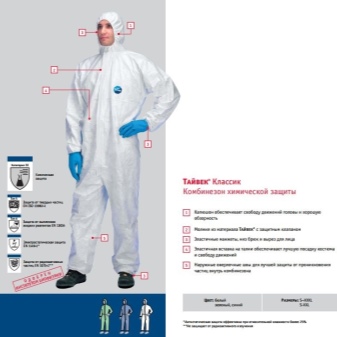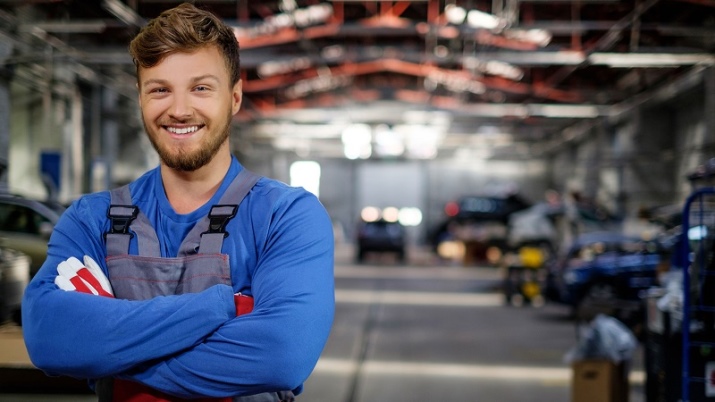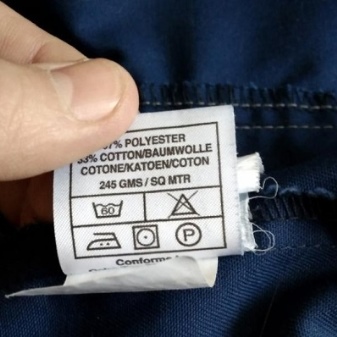Varieties
The design and functional features of the overalls depend on the specifics of the conditions in which it is intended to be used. Depending on the type of cut, which is associated with the functional purpose of the product, it is customary to distinguish between overalls:
- open (semi-overalls), which are pants with a bib and shoulder straps;
- closed (deaf), representing a jacket with sleeves, combined with pants in one piece.
Modern manufacturers offer consumers a wide selection of various models of overalls with buttons, Velcro, and zippers. Models with double zippers are popular, which greatly simplifies the process of putting on and taking off equipment. Depending on the recommended duration of use of the product, a distinction is made between disposable and reusable overalls.
Seasonality
The style of the overalls is also determined by the seasonality of the work for which it is intended. The same factor affects the type of material from which the product is made. Summer overalls are usually made of lightweight, durable materials with moisture and windproof properties.

The most convenient for working outdoors in hot conditions are transformer overalls with a detachable top. Most often, light-colored overalls are used for summer work in the open air.
Winter overalls for work in conditions with low air temperatures are made of moisture-proof materials with high thermal insulation properties. To prevent heat loss when working in cold weather, such models of overalls are usually equipped with additional auxiliary elements - removable hoods, elastic cuffs, drawstrings, lining made of thermal insulating material.
Materials (edit)
The most popular material for the manufacture of overalls is twill weave. This fabric is characterized by increased strength, wear resistance, and hygiene. Possessing good air permeability, it helps to maintain an optimal microclimate inside clothes, ensuring the comfort and convenience of a person working in high temperatures.
Tyvek is a non-woven, durable and environmentally friendly material characterized by high strength, vapor permeability, moisture resistance, low weight. This high-tech material, made of very dense polyethylene, is resistant to both mechanical and chemical attack.


Tarpaulin is a type of heavy and dense fabric impregnated with special compounds that give the material fire and moisture resistance. Not only heavy-duty types of workwear are made of tarpaulin, but also covering materials and structures - tents, awnings, awnings. The disadvantages of tarpaulin products are considered to be significant weight, lack of elasticity.
Denim is also often used to make work overalls. It is hygroscopic, resistant to mechanical stress, and has good air permeability. At the same time, denim overalls weigh much less than tarpaulin equipment.
Colors
The colors of the overalls usually allow others to determine the specifics of the worker's activity. For example, overalls of bright orange, red and lemon-yellow colors, which have high contrast and ensure maximum visibility of a person at dusk, as well as at night and in the morning, are often used by road workers, builders, and emergency service specialists.
White coveralls reflect the sun's rays, so they are often used as equipment when working outdoors. Such overalls are very popular among craftsmen-finishers - plasterers, painters.Also, light-colored overalls are used in the medical field (laboratories, expert bureaus), as well as in the food industry. Black, blue and gray overalls are more resistant to dirt than light-colored overalls.
Peculiarities
Like any other type of workwear, work overalls have a number of specific features that distinguish them from everyday wardrobe items. One of these features is the increased ergonomics of the product, which ensures the convenience and safety of a person carrying out a certain type of activity.

This type of workwear must have such properties as:
- dust and moisture resistance;
- fire resistance (non-flammable);
- resistance to mechanical and chemical stress;
- light weight;
- elasticity.
The work overalls should not restrict or restrict the user's movements, impede blood circulation, squeeze the body and / or limbs. The style of the product must be designed in such a way that the employee can freely carry out movements of a certain amplitude (tilting the body forward, backward and to the sides, abduction / bending of the arms and legs).
Depending on the specifics of the activity for which the overalls are designed, it may have certain functional details. These include:
- elements for fastening the safety system;
- reinforced protective pads (for example, on the knees, chest and elbows);
- windproof valves;
- additional pockets;
- reflective stripes.
Overalls models designed for certain types of activities may have a special color. This may be due to both safety requirements imposed, in particular, on signal clothing, and the specifics of working conditions, for example, when working in the bright sun in hot weather.

Work overalls, like any workwear, may have additional elements of distinction. Such elements include stripes or applications with the company logo, an emblem containing the letter designation of groups and subgroups of harmful external influences (mechanical, thermal, radiation, chemical effects).
Exploitation
To prevent arbitrary unbuttoning of the straps of the overalls during work, it is necessary to learn how to correctly fix them in the holes of the fastex (a special plastic buckle with a trident). So, in order to securely tie the straps of workwear, you must:
- unfold the fastex (buckle) with the right side facing you;
- pass the end of the strap into the hole located next to the trident;
- pull the end of the strap towards you and thread it into the second hole located farther from the trident;
- tighten the strap.
During the use of work clothing, the recommendations provided by the manufacturer should be strictly observed. So, in overalls made of flammable materials, it is strictly forbidden to work near open fire or sources of high temperatures. To work in poor visibility conditions, it is necessary to use only signal clothing or equipment with reflective elements.


In the next video, you will find a review of the Dimex 648 winter overalls.
